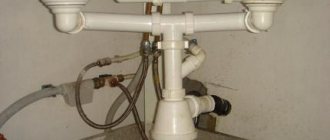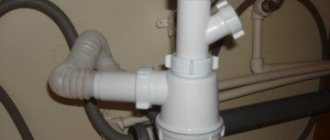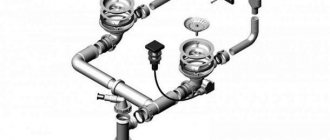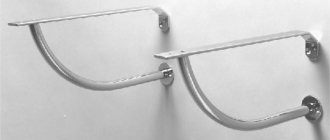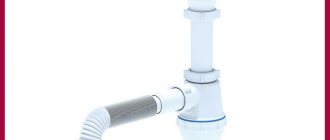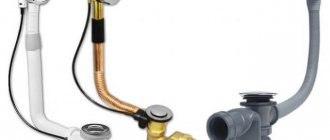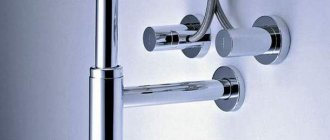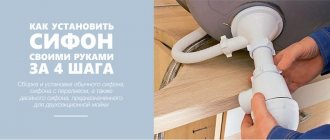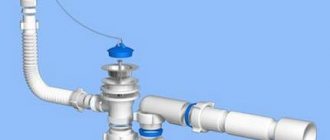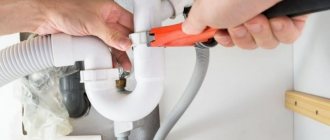Any self-respecting man, or even your teenage son, will be able to understand how to assemble a sink siphon on his own. After all, this requires only a minimum of effort, a few simple skills, one screwdriver and maximum desire.
What every housewife knows about this device is that it can become clogged and need to be cleaned, or it can leak and then may need to be replaced with a new one. If there is a man in the house, there is no problem. Otherwise, you will have to turn to the paid services of a specialist.
Purpose of the siphon
Whether you live in a private house or in an apartment, if your home has a sink, washbasin, bathtub or shower, then there are siphons there. You can do without this plumbing device only in the case of an outdoor washbasin.
Siphon
A siphon is a curved section of pipe through which waste water is drained from a sink/bathtub/shower tray into the sewer system. Connecting a sink to a sewer is impossible without this plumbing fixture. After all, it is what retains unpleasant odors coming from the sewer pipe and prevents the growth of bacteria thanks to the water seal that it forms.
It is also necessary to connect a siphon to the sewer to catch coarse debris that, for whatever reason, ends up in the drain. It is important to immediately note that the plumbing device in question is not capable of fully protecting the sewer system from clogging. It is necessary to periodically use additional chemicals intended for drain cleaning.
Connection to sewerage
The last stage is connecting to the sewer. If the sewer pipe is made of PVC, a threaded connection with a sealing gasket is used. In the case of a cast iron pipe or a mismatch in diameters, you will have to purchase a rubber adapter coupling. The siphon pipe must extend into it at least 5 cm, and do not forget about the sealant.
USEFUL INFORMATION: Where and how to use moisture-resistant putty
After assembly is completed and all connections are tightened and the sealant has set, a leak test is carried out. To do this, fill the bath until water flows through the overflow hole. The absence of liquid drops at the connection points will indicate that the siphon is installed correctly.
Types of siphons
Before we begin to analyze the question of how to properly connect a siphon to a sink or other plumbing fixture, let’s look at what types of siphons exist. After all, having decided to purchase this product, you will first of all think about its variety, which is necessary specifically in your case. For greater clarity, consider the following images.
Types of siphons
As can be seen from the above pictures, the most functional and easy to install today is the bottle siphon. We will stop there.
Basic equipment of a bottle siphon
To answer the question of how to install a bottle siphon on a sink, you must first consider what parts it consists of. The main components of a bottle siphon for a sink or bath are:
- protective grille;
- set of rubber gaskets;
- conical rubber cuffs;
- inlet or outlet pipe;
- connecting screw;
- coupling nut;
- bottom;
- connecting nut for sewer pipe;
- drain pipe.
Basic equipment
Device selection
When choosing a siphon for a sink, you must consider the following parameters:
- Size - depends on the free space in the sink; if there is not enough space, you can buy a special, flat siphon.
- Diameter of pipes.
- Complete set - pipes, gaskets, etc.
- Quality - the surface must be free of chips, cracks, burrs, etc.
- Manufacturer - the price range depends on this.
| Model | Viega Siphon | Vitra Syphone | Vitra Syphone | Viega Siphon | AlcaPlast | AlcaPlast |
| A country | Germany | Türkiye | Türkiye | Germany | Czech | Czech |
| View | Bottle | Bottle | Tubular | Tubular | Bottle | Tubular |
| Cost, rub.) | 150 | 280 | 350 | 620 | 300 | 420 |
Various modifications of bottle siphons
Depending on your device model, it may have additional parts such as:
- several inlet pipes;
- overflow pipe;
- auto drain valve.
If you will have a washing machine next to the sink on which you are installing the siphon, you should consider purchasing a model with a special additional inlet pipe. It is much easier and more convenient to connect household appliances to the sewer through a siphon, rather than directly.
The overflow pipe is installed on a sink, the design of which initially includes an overflow hole. To avoid flooding in the kitchen, manufacturers of bathroom and kitchen sinks have recently begun to equip them with an overflow hole, and manufacturers of siphons have begun to equip their products with an overflow pipe.
Siphon with overflow
Auto-draining is a very convenient feature of modern models. When there is a need to fill the sink with water, just simply press to close the valve on the drain. Then, when you no longer need the water in the sink, the valve opens and the drainage continues as usual.
Auto drain
The image below shows one of the modifications of the bottle siphon. In general, they all have a similar device, but which modification of the siphon for the bathroom sink to choose is up to you to decide based on your specific conditions.
Siphon with stopper
There are also models of siphons for double sinks. The convenience of this model is that you do not have to install the sink siphon twice. And this will significantly save your time and effort. But not only. The model with two inlet pipes is more compact, which is important for productive use of the space under the sink. By installing 2 separate siphons on a double-bowl sink, you create a web of pipes and hoses under the sink. This will not only prevent you from placing a trash can there, for example, but will also make the sewer unit difficult to maintain.
Siphon for double sink
Assembly and installation
Replacing an old siphon with a new one is not a big problem even for a non-professional. It is enough to follow the recommendations of specialists and observe the sequence of work performed.
How to remove the old one
The only tool you need is a large screwdriver. Water from the flask may spill onto the floor when removed, so place a basin under the siphon before starting work.
Holding the device from below, use a screwdriver to unscrew the screw located in the center of the drain grate in the sink. Next, disconnect the drain pipe from the sewer system. The siphon has been removed.
Often the screw becomes tightly stuck to the nut. In this case, remove the siphon from the inlet pipe by unscrewing the tightening nut, disconnect it from the sewer and remove it. The remaining pipe is turned several times, holding the screw in place with a screwdriver. Usually this is enough to unscrew the connection.
Removing the old siphon is not difficult at all
If this does not help, treat the contact area between the nut and the screw inside the pipe with kerosene or WD-40, wait 5–10 minutes and repeat the manipulations. After dismantling the old siphon, the sink drain neck is thoroughly cleaned of scale and debris. The inner surface of the sewer socket should also be cleaned of deposits and covered with a plug of suitable diameter or a damp cloth.
How to assemble a new one
Before you begin assembling the bottle siphon, all the parts are laid out and grouped according to their intended purpose. The kit should include:
- 2 parts siphon flask;
- Filler pipe with a seat in the form of a plate (funnel);
- Corrugated drain pipe;
- Flat and cone sealing rings of different diameters;
- Tightening nuts;
- Metal drain grate with screw.
Before assembly, you need to check the presence of all components.
It is worth noting that the diameter of all pipes is different; sealing gaskets and nuts of a certain size are suitable for them. Assemble the siphon in the following sequence.
The largest flat gasket is placed over the large threaded hole on the siphon. A flask (glass) is screwed to this hole. The result is a barrel with 2 holes of different diameters on the top and side. Each of them is threaded.
Assembly begins by attaching the bulb to the hole
First put a nut on the filler pipe with a funnel, then a conical gasket of a suitable diameter with the blunt side facing the funnel. The pipe is deepened to the sealing ring into the upper hole of the siphon and tightly fixed with a nut. Sometimes the drain funnel and pipe are supplied separately. Then they are pre-assembled into one whole using a nut with an O-ring. The funnel contains a metal nut. You need to make sure that it does not fall out of its seat during the assembly process.
Sequence of actions when connecting a drain funnel
In the same sequence, attach the drain pipe to the side hole on the siphon body: put on the nut, push the cone seal with the blunt end to the nut, insert the pipe into the hole, tighten the nut tightly.
Attaching the drain pipe to the side hole
It is important! The nuts are made of plastic, so they are tightened with little force. Under heavy load, they can burst and the O-rings can become deformed.
The remaining parts are needed to attach the siphon to the sink and sewer.
Video: assembling the structure for the washbasin
If there is an overflow, it is connected to the filler pipe on the assembled siphon. The procedure is the same: put a nut with a seal on the overflow, insert it into the hole in the pipe, tighten the nut.
How to install a siphon correctly
The siphon assembly is placed under the sink and the following steps are performed:
- A flat corrugated gasket is placed in the funnel of the filler pipe with the stripes facing up. The remaining rubber ring is pulled onto the metal grid.
- The siphon funnel is pressed against the neck of the sink drain. Control the vertical of the siphon.
- A metal grill is placed on top of the neck at the bottom of the sink.
- A screw is inserted into the central hole of the grille and screwed into the funnel nut using a screwdriver. Control the force so that the gaskets are pressed tightly, but not deformed.
- Place a suitable shaped gasket into the overflow funnel with the corrugated side up and press it tightly against the overflow hole on the sink. It is fixed with a screw inserted into the central hole of the sink overflow.
- The corrugated outlet pipe is stretched to the required length and inserted into the sewer pipe using special seals.
Finally, turn on the water and check the entire structure for leaks. A leak found at any connection can be easily eliminated by tightening the nut more tightly.
Summarize
Assembling a siphon for a sink, washbasin, shower cabin or bathtub does not take much time and does not require special skills. However, there are a number of nuances that you should be aware of and take into account so that you do not have to do double work by redoing something. You need to take everything into account so that you don’t soon need to replace a completely new device with a more functional model, because you forgot to take into account that you will place a washing machine nearby and it will also need to be connected to the sewer through a siphon.
If you are new to plumbing and are installing a siphon for the first time, the manufacturer’s instructions for the product may be incomprehensible in some ways. Having only a schematic description of the assembly and installation sequence of the device, it does not contain important information and tips that will help you avoid mistakes and protect your kitchen from sewer leaks.
